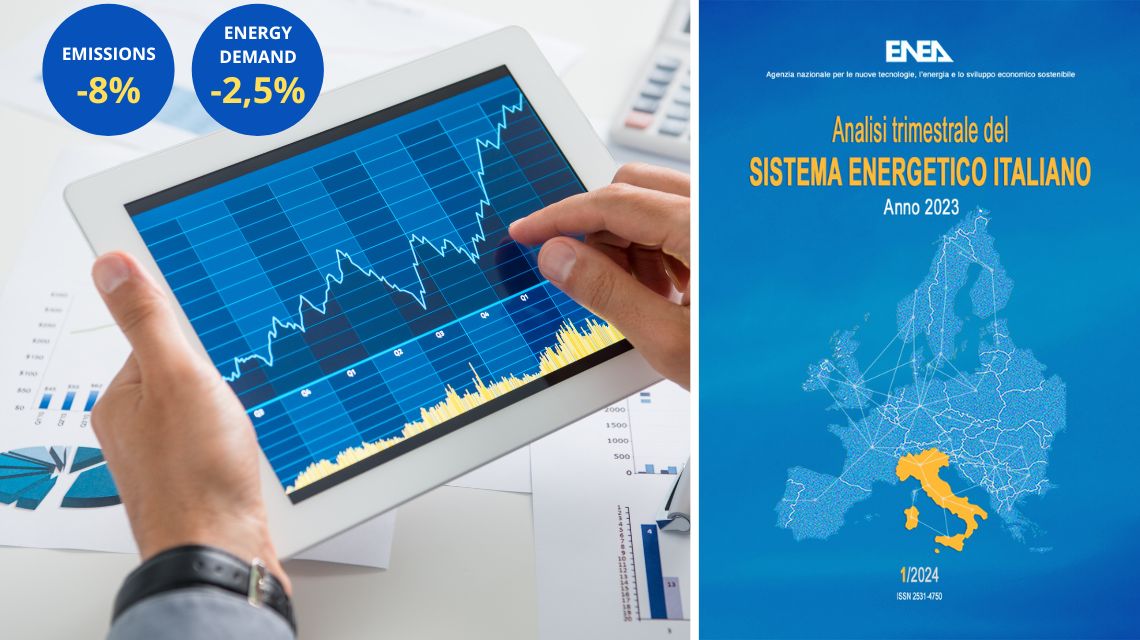Italian National Agency for New Technologies, Energy and Sustainable Economic Development

Energy: ENEA Analysis for 2023, CO2 emissions down by 8%, energy demand down by 2,5%
New high for solar and wind output. Share of fossil fuels at the lowest in 50 years
In 2023 the national energy scenario was characterized by a sharp drop of carbon dioxide emissions (-8%) and a further decline of primary energy consumption (-2.5%), slightly lower than the one recorded in the Eurozone (- 3%). Oil is again by far the main Italian primary energy source (35% of total energy supply). However, overall, the share of total energy supply covered by fossil sources - oil, gas and coal – fell to 71%, minimum in 50 years. These are some highlights of the latest Quarterly Analysis of the Italian energy system by ENEA, relating to the whole year 2023. Moreover, last year marked a new high for wind and photovoltaic, which covered 17.5% of demand on an annual basis, thanks to an accelerated growth of installed capacity. “This growth represents the main, if not the only, virtuous driver of the ongoing decarbonisation trend”, explains Francesco Gracceva, the ENEA researcher who coordinates the analysis. “The decline in primary energy is due to the substantial drop of fossil sources, such as gas (-10%), coal (-30%) and oil (-2%), only partially offset by the growth of renewables production (+ 13%) and electricity imports (+19%), which rose to an all-time high” he adds.
The drop in energy demand “is mainly due to non-structural factors, such as the decrease in gas consumption in the first quarter of 2023, due to a very mild winter, the national plan to contain gas and electricity consumption, the high level of gas and electricity prices, as well as the shrinkage of industrial production, particularly strong in some energy-intensive sectors (where it is now below the 2020 levels)”, continues Gracceva. The only sector with growing energy demand is transportation (+2%), whose demand is back to pre-crisis levels, driven by the aviation sector (+20%).
As regards the fall in CO2 emissions (-25 Mt, -8%), most of it is due to the fall in fossil fuels consumption in the ETS sectors (electricity generation and energy-intensive industry), whose emissions are estimated to have decreased by 16%. Indeed, about 70% of the decrease in CO2 emissions is explained by the “readjustment” of the fuel mix in the power sector, which had been upset by the energy price shock in the previous year. “The increase in carbon intensity recorded in 2022 proved to be a temporary phenomenon, due to a set of non-structural factors: in 2023 hydroelectric production increased by 10 TWh (from the historic low recorded in 2022), power generation from coal (-9 TWh) and fuel oil dropped with the end of the national plan to maximize their use (to face the gas price shock), while electricity import (+8 TWh) has reached a new historic high”, underlines Gracceva. The remaining 30% of the fall in CO2 emissions (about 6 Mt) is attributable to the decrease of gas consumption in buildings (non-ETS sectors), whose emissions are estimated to fall by 3%.
In this scenario, the energy transition index ISPRED (Index Security and Prices of Energy supply and Decarbonization), measured by ENEA to assess the progress of the Italian energy transition, records a significant improvement year on year (+ 25%), after it had collapsed to its record low in 2022, penalized by the unprecedented high energy prices and the increase in CO2 emissions.
“In the near-term it is likely that the decarbonisation trend will continue in the power sector, although at a slower pace”, underlines Gracceva. “However, it remains difficult to achieve the very high rate of emissions reduction (around -5% yoy) which is necessary to reach the 2030 decarbonisation target”, concludes Gracceva.
As regards energy prices, in 2023 the average prices of gas and electricity remained at historically high levels, continuing to exert pressure on energy demand: in the fourth quarter of 2023 the price of gas at the Italian hub (Punto di Scambio Virtuale) was over €40/MWh, almost twice the pre-2022 long-term average, while the price of electricity on the Italian Electricity Exchange was equal to €124/MWh, over twice the pre-crisis average.
This ENEA Quarterly Analysis includes a Focus on the recent trend of energy-related research and development expenditures. Public spending on energy research had a strong global expansion in the 2019-22 period (+25%), concentrated on a set of “enabling” technologies: growth was particularly strong in energy efficiency (almost a quarter of total public spending on energy research), while there was a slowdown in R&D spending on renewables. The global upward trend has not been shared by the Italian economy, where growth in total public spending on energy research has been much lower (+0.6%). Public spending increased only in the hydrogen (+160%) and nuclear sectors (+40%), while it decreased in the energy efficiency sector (-12%).
